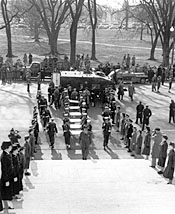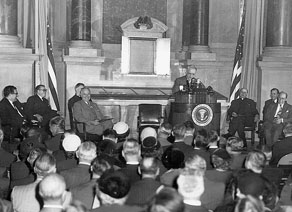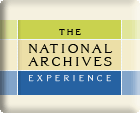November & December 2002 Feature
Moving the Charters of Freedom
Milton Gustafson
Archivist, Textual Archives Services Division
National Archives and Records Administration
 |
| Fifty years ago, on December 13, 1952, the Declaration of Independence and the Constitution were transferred to the National Archives. (NARA, 64-NA-1-434) |
Fifty years ago the Declaration of Independence and the Constitution of the United States were transferred from the Library of Congress to the National Archives. Joining the Bill of Rights, which had been in the Archives' care since 1938, they became collectively known as the Charters of Freedom, the most precious documents in our heritage.
Today these documents are receiving important conservation treatment while the Rotunda of the National Archives Building undergoes a major renovation. When it reopens in September 2003, it will feature the Declaration of Independence, the Bill of Rights, and on permanent display for the first time, all four pages of the Constitution, as well as its Transmittal Page. All seven pages of the Charters will be placed in new state-of-the-art encasements that will preserve them for generations to come.
The Department of State was the custodian for these three great documents for most of their existence, and during the early republic they moved with the government from New York to Philadelphia to Washington, DC. When the British attacked Washington in 1814, they were evacuated to Leesburg.
Unlike the Constitution and Bill of Rights, the Declaration was kept on display, and sunlight and fireplace smoke took their toll. In 1841 the Declaration was placed on exhibit in the new Patent Office Building, then it was sent Philadelphia for the centennial exposition in 1876. Back in Washington in 1877, it was displayed at the State-War-Navy Building until 1894.
In 1921 the State Department decided that the Declaration and Constitution should be transferred to the Library of Congress, where they could be safely shown to the American public. After signing a receipt, Herbert Putnam, the Librarian of Congress, placed the two documents on some mail sacks in the back of a Model-T Ford truck and delivered them to his office safe. The formal exhibit opening on February 28, 1924, was a simple ceremony. President Coolidge attended, but no one spoke, and it concluded with everyone singing two stanzas of "America." Except for a brief stay in Fort Knox during World War II, the Declaration and Constitution were at the Library of Congress until 1952.
In contrast, the ceremony on December 13 for the transfer from the Library of Congress to the National Archives was more spectacular. Twelve members of the Armed Forces Special Police carried the six parchment documents, encased in helium-filled glass cases and enclosed in wooden crates, through a cordon of 88 servicewomen and placed the boxes on mattresses in an armored Marine Corps personnel carrier. A color guard, ceremonial troops, the Army Band, the Air Force Drum and Bugle Corps, two light tanks, four servicemen carrying submachine guns, and a motorcycle escort paraded down Pennsylvania and Constitution Avenues to the Archives Building, with Army, Navy, Coast Guard, Marine, and Air Force personnel lining the parade route. Then the 12 special policemen carried the crates up the steps to deliver them to the custody of the Archivist of the United States.
 |
| President Truman and other dignitaries listen to Chief Justice Vinson delivering the closing remarks at the enshrining ceremony. (NARA, 64-NA-1-458) |
Two days later, on Monday, December 15, 1952, Bill of Rights Day, the formal enshrining ceremony was equally impressive. The State Department had transferred the Bill of Rights to the National Archives in 1938, and it had been encased in helium like the other two documents. Officials from more than 100 national civic, patriotic, religious, veterans, educational, business, and labor groups crowded into the Exhibition Hall. The Chief Justice of the United States presided, and the chaplain of the Senate gave the invocation. As the Governor of Delaware called the roll of states, a servicewoman carrying that state's flag entered the hall and remained at attention throughout the ceremony. President Truman was the main speaker, but the chairman of the Joint Committee on the Library (which had ordered the transfer), and the Chief Justice also made remarks. The Librarian of Congress and the Archivist of the United States jointly unveiled the new shrine.
Come September 2003, when the National Archives and Records Administration re-opens its grand exhibit space, visitors may once again view these precious documents, and as Truman said 50 years ago, "the sight of these symbols will lift up their hearts, so they will go out of this building helped and strengthened and inspired."
PDF files require the free Adobe Reader.
More information on Adobe Acrobat PDF files is available on our Accessibility page.
